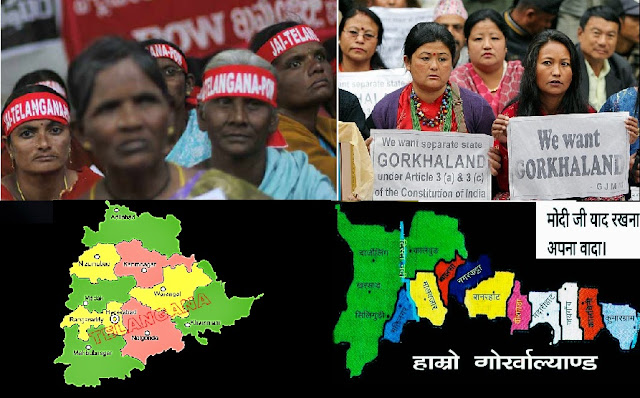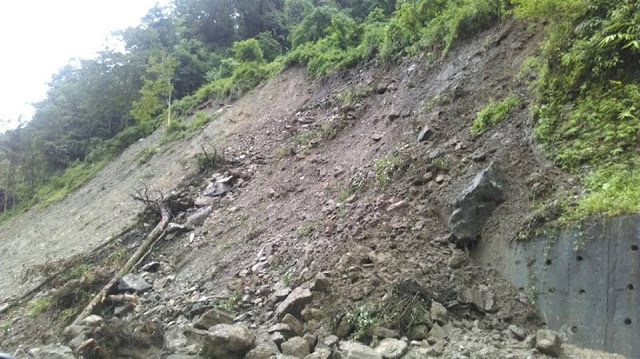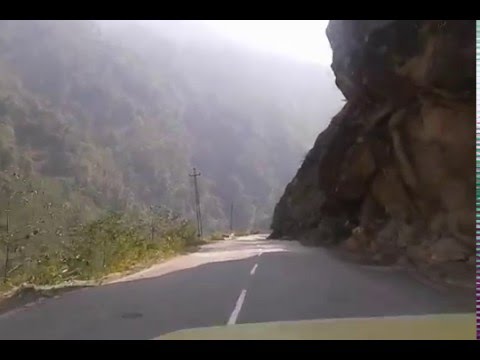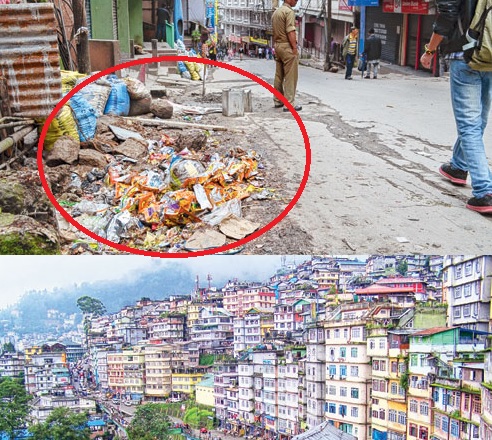'Demerger' and Statehood
Similarities between Gorkhaland and Telangana
Writes Bivek Tamang (btamang@cus.ac.in) teaches at the Department of Commerce, and Sangmu Thendup (sthendup@cus.ac.in) at the Department of History, Sikkim University, Gangtok.
The Darjeeling Hills and surrounding areas were merged with West Bengal in 1947. This article argues that the formation of Telangana opens the door for accepting the century-old demand of the Indian Gorkhas for a separate homeland. It also argues against the use of the term separatism to describe the demand of the Indian Gorkhas and instead suggest the terms "merger" and "demerger." Darjeeling, whose merger with West Bengal was, at best, a post-independence administrative exigency, could now be demerged, much like Telangana from Andhra Pradesh.
Darjeeling District is in the northernmost part of West Bengal, bounded on the north by Sikkim, Bhutan on the east and Nepal on the west (Dewan 1991: 29). Prior to its acquisition by the English East India Company in 1835, Darjeeling was a part of Sikkim. For a brief period before that, it was a part of Nepal. Before 1816, the whole of the territory known as British Sikkim belonged to Nepal, which had conquered it and annexed it from Sikkim. On 4 March 1816, it was ceded to the East India Company. The treaty of Segauli enjoined Nepal to ceding Darjeeling to the East India Company.
 |
| 'Demerger' and Statehood, Gorkhaland and Telangana |
The company then handed the area over to the Raja of Sikkim through a treaty signed at Titalya in 1817 (Dozey 1922: 2). On 10 February 1817, the British restored Darjeeling to the Sikkimese. However, on 1 February 1835, the area was transferred by a deed of grant to the East India Company (Sen 1989: 16–17). The transferred land included the hill lands east of the Mechi and part of the terai between the Mechi and the Teesta.1 Henceforth, the East India Company assumed a position of paramount importance in Sikkim; the company’s arbitration was to be sought in any dispute between Sikkim and her neighbouring states (Chakraborty 2008).
A Worthless Mountain
Darjeeling was then a worthless, uninhabited mountain. In 1841, the government granted the Raja of Sikkim an allowance of Rs 3,000 as compensation. It raised the grant to Rs 6,000 in 1846 (O’Malley 19o7: 21).
About 15 years later, the relations between Sikkim and the British government turned sour. The old and infirm raja had allowed his “mad” Prime Minister Diwan Namguay, a “corrupt” and “ambitious” official, to administer the state. But Namguay, who wanted to enrich himself, did not like the increasing importance of Darjeeling under the British. He was joined by the Lamas and other notables—disgruntled after losing their rights over slaves who were now British subjects in Darjeeling—in a rebellion.
Tension reached its climax in November 1849, when two officials of the East India Company, Joseph Hooker and A Campbell, were captured and imprisoned while they were travelling in Sikkim. The British sent a punitive expedition in February 1850. This resulted in the annexation of the terai2 and the portion of Sikkim hills bounded by the Rammam and the Great Rangeet rivers on the north, by the Teesta on the east, and by the Nepal frontier on the west, covering an area of 640 sq miles. The superintendent, now called the deputy commissioner, was made in charge of the annexed territory.
Relations between Sikkim and the British government remained peaceful, except when Namguay raided this territory, plundering property and abducting inhabitants for sale as slaves in Sikkim. In retaliation, the British threatened to annex a part of Sikkim, north of the Rammam and the west of the Great Rangeet. The British forces reached Tumlong, Sikkim’s capital, in early 1861. A new treaty with the raja was signed.
Subsidiary Alliance
While the colonial state’s troubles with Sikkim were resolved, there were problems with the neighbouring state of Bhutan. The Bhutanese created trouble for the colonial state on the frontier. The Government of India was determined to annex the Bengal Dooars3 and much of the hill territory including the fort of Dalingkot,4 to prevent the hostile incursions of the Bhutanese. The fort was captured with great ease and the Dooars were occupied by January 1865. In 1866 the tract, which now forms the Kalimpong subdivision, was added to the district of Darjeeling. This was the last addition to the district, which now acquired its present dimensions: its area increased from 640 sq miles to 1,164 sq miles (Dozey 1922: 2).
The East India Company’s policy of annexation had been well institutionalised by the Subsidiary Alliance system introduced by Dalhousie for the large-scale expansion of British rule in India and its neighbouring areas. The Subsidiary Alliance was put into effect by Wellesley (1798–1805), although its basic principles had been formulated earlier by the French in Southern India. According to the principles of this alliance system, any Indian ruler accepting the alliance was to maintain British forces within his territory and make the necessary financial arrangements for its upkeep. This could assume the form of territorial cessions as well. The ruler also had to maintain a British resident in his court, whose intervention in foreign policy issues had to be accommodated. In short, the native ruler lost a considerable part of his autonomy. The Nizam of Hyderabad was the first to enter into this alliance. Tipu Sultan rejected it summarily, while Baji Rao II, the Maratha leader, entered into this alliance (Treaty of Bassein 1802) in a futile attempt to regain control over his warring chiefs (Subramanian 2010: 65).
By signing a Subsidiary Alliance, the ruler of a state virtually signed away independence. States lost the rights of self-defence, maintaining diplomatic relations, employing foreign experts and settling its disputes with its neighbours. Rulers lost all vestiges of sovereignty in external matters and became increasingly subservient to the British Resident, who would interfere in day-to-day administration of the state. The Subsidiary Alliance system was advantageous to the British. They could now maintain a large army at somebody else’s cost. The British adopted the same policy to annex parts of Sikkim, Nepal and Bhutan.
In 1840, Darjeeling was officially recognised as a district (Sen 1989: 16–17). The district’s four subdivisions—Darjeeling, Kurseong, Kalimpong and Siliguri—were demarcated in 1866. The district was formerly a non-regulation district, and it had no representative in the Legislative Council constituted under the Government of India Act, 1919. It was excluded and declared a backward tract. Under the Government of India Act 1935, the district was made a partially excluded area.
The Fourth Phase
After India became independent, Darjeeling, which was never a part of Bengal, was absorbed into West Bengal only in 1954 under Schedule V of The Absorbed Areas (Laws) Act 1954 (Act No 20 of 1954). The district lost all special privileges, and all statutes, except the Bengal Tenancy Act in certain areas, applied to it (Banerjee et al 1980: 95).
With its hundred year-old movement for separate homeland, Darjeeling has many similarities with Telangana. The Gorkhaland movement may not actually be a movement for separation; it would be apt to see it as a case of merger and demerger. Ideally, Darjeeling should have gone back to Sikkim in 1947, which was a separate country then. The Absorbed Areas (Laws) Act 1954 proves that the merger of Darjeeling with Bengal was only for administrative purpose and convenience.
The first petition for a separate homeland was submitted in 1907 by the leaders of the hill people led by Sonam Wangel Ladenla, the first hillman to retire as assistant superintendent of the Darjeeling police. The petition demanded a separate administrative set up for the district of Darjeeling (Lama 2008: 199). Thereafter, there have been numerous petitions, memorandums and demands including two major movements, one in the 1980s and the other from 2007 onwards, demanding a separate state within the Indian union for the Indian Gorkhas of the Darjeeling hills and the surrounding areas.
The dynamics of India’s political scenario has led the discourse of the statehood demand to revolve largely around linguistic differences, but it has also encapsulated economic and developmental differences. However, with the formation of Telangana, a discourse patterned on “merger and demerger” has emerged.
Separatism may be defined as an instance of political disintegration, wherein political actors in one or more sub-systems withdraw their loyalties, expectations and political activities from a jurisdictional centre and focus them on a centre of their own (Hass 1968: 16). Linguistic separatism, cultural separatism, regionalist separatism based on economic and political grievances, aboriginal separatism and separatism based on the notion of sons of soil have been recognised as different forms of separatism (Wood 1981).
The first era of separatism or reorganisation of territory in India began in 1956. Such separatism had a linguistic basis. Needless to say the era opened up a plethora of demands for statehood in India. The second era of reorganisation was initiated during the 1970s with creation of north-eastern states from the division of Assam after the formation of Nagaland in 1963 and Meghalaya in 1972. The third phase, in 2000, was marked by Uttaranchal, Jharkhand and Chhattisgarh being carved out of Uttar Pradesh, Bihar and Madhya Pradesh, respectively (Chadda 2002: 44–61). The fourth phase may have just begun to unfold with the creation of Telangana and could be followed by the creation of newer states in the country.
Ironically, reorganisation of the political boundary of a state or creation of a separate state within the Indian union itself and an extremist exercise to separate from the Indian union are all labelled as separatism in existing political literature and discourse (Horowitz 1981: 65–95). Some modern theorists view separatism as detrimental to national integration and as conflicting with the process of nation building (Datta 1988: 517–36; Nag 1993: 1521–32).
Separatism invariably brings back the “collective memory”5 of struggle, trauma, separation amongst kin, violence, death, genocide, resource sharing struggles, hurt ethnic ethos and other similar memories precisely to those who have witnessed and experienced the terrible side of separatism. Thus, reorganisation of Indian states is often viewed as separation and disintegration of India (Chadda 2002: 44–61).
The concept of demerger customarily reflects the history of merger and association. But unlike corporate merger (and acquisition), political merger invariably brings the need and relevance of history and administrative rights. Prime Minister Jawaharlal Nehru once said, “where merger is not desirable, let divorce take place.” This statement has been quoted a number of times in the context of Hyderabad and Telangana (The Hindu Centre for Politics & Public Policy 2013). But in the context of Gorkhaland it may be pertinent to say “where merger has not pleased, let demerger take place.” In order to relate the use of the terms merger and demerger for the creation of Gorkhaland (or any name), it would be fitting to compare it with the case of Telangana and its merger and demerger from Andhra Pradesh.
Bengal must see the Gorkhaland movement as an opportunity of demerger. West Bengal can focus and provide more attention and efficient governance to the remaining districts which share history, language and culture rather than bearing the burden of governing a district with unfamiliar history, ethnicity, language and culture. Gorkhaland can prosper like other smaller states in the country.
Conclusions
Two historical developments, the partition of India in 1947, and the emergence of Bangladesh in 1971, have had “push-effects” on the statehood demand for the Gorkhas. During 1947 and 1971, a huge number of refugees from East Pakistan (now Bangladesh) crossed the open border and settled in the plains of Darjeeling District. Such influx led to a rise in Bengali speakers, who eventually surpassed the “Gorkhali”/Nepali speakers in the plain/terai region. The movement became more intense after “losing lands” to refugees. In 1985, there was a violent anti-outsider movement in North-east India. After this, many Nepalis were displaced (Banerjee and Stöber 2013) from places like Meghalaya.
Telangana and Darjeeling share similar traits if we look at their histories of merger. The formation of Telangana through the process of demerger has opened up a whole new political discourse of “demerger” as a basis of forming new states in India. Fears of violence, ethnic conflict and other apprehensions of people, political experts, analysts, and political leaders seem to have been allayed. No major incident of violence post-demerger of Telangana from Andhra Pradesh has been reported. The formation of Telangana could be cited as an example of a problem-solving method rather than as one creating a problem. The Telangana example could perhaps prove salutary in solving the Gorkhaland issue. A separate state, Gorkhaland (or any other name) could solve the century-old problems of ill governance, exploitation and historical blunder in the Darjeeling Hills and neighbouring areas. The demerger of Darjeeling Hills from Bengal and the formation of a new state, may not lead to violence or ethnic conflict. West Bengal and Gorkhaland (or any name) could, like Telangana and Andhra Pradesh, coexist peacefully.
notes
1 Popularly known as Morung during those days.
2 Foothills of the Himalayas.
3 The term “Dooars” comes from the word “Duar” meaning door in Nepali, Bengali and other associated languages as the region form a gateway to Bhutan from India. Dooars are the floodplains and foothills of the eastern Himalayas in North-east India around Bhutan.
4 An old Bhutanese fort situated in the south-east of the Kalimpong tract to the east of the Teesta. The fort which was stormed by the British troops in the Bhutanese War of 1864–65 is situated at a height of 3,350 feet above sea-level on a lofty eminence over-looking the Dooars (O’Malley 1907: 181).
5 Collective memory is a part of memory science and refers to the shared pool of information held in the memory of two or more members of a group/community, experienced together as a group/community.
References
Banerjee, A K et al (1980): West Bengal District Gazeteers Darjeeling, Calcutta: Government Printing.
Banerjee, B K and Georg Stöber (2013): “Gorkhaland Movement in India: A Case of Indigeneity and/or a Struggle over Space?” Geographien Südasiens, 3 Jahrestagung des AK Südasien, 25/26 Januar, Heidelberg.
Beary, Brian (2008): “Separatist Movements: Should Nations Have a Right to Self-Determination?” CQ Global Researcher, Vol 2, No 8, April.
Chadda, M (2002): “Integration through Internal Reorganization: Containing Ethnic Conflict in India,” The Global Review of Ethnopolitics, Vol 2, No 1, September, pp 44–46.
Chakraborty, Chhanda (2008): “Hill History,” The Statesman, 17 July.
Datta, Prabhat Kumar (1988): “Separatism in Indian Politics,” The Indian Journal of Political Science, Vol 49, No 4, October–December, pp 517–36, Indian Political Science Association.
Dewan, Dick B (1991): Education in the Darjeeling Hills: An Historical Survey 1835–1985, New Delhi: Indus Publishing Company.
Dozey, E C (1922): A Concise History of the Darjeeling District since 1835 with a Complete Itinerary of Tours in Sikkim and the District, 2nd ed, Calcutta: Art Press.
Hass, E (1968): The Uniting of Europe, Stanford: Stanford University Press.
Horowitz, D L (1981): “Patterns of Ethnic Separatism,” Comparative Studies in Society and History, Vol 23, No 2, April.
Lama, Basant B (2008): Through the Mists of Time: The Story of Darjeeling, Kurseong: Bhawani Offset Printing and Publication.
Khan, Mohammad Abu Tayyub (2011): “Saga of Bengal Partition,” The Journal of History and Social Science, Vol 2, No 1, January to June.
O’Malley, L S S (1907, reprint 1985, 1999): Bengal District Gazetteers Darjeeling, New Delhi: Logos Press.
Nag, Sajal (1993): “Multiplication of Nations? Political Economy of Sub-Nationalism in India,” Economic & Political Weekly, Vol 28, No 29–30, pp 1521–32.
Sen, Jahar (1989): Darjeeling: A Favoured Retreat, New Delhi: Indus Publishing Company.
Subramanian, Lakshmi (2010): History of India 1707–1857, New Delhi: Orient Blackswan.
The Hindu Centre for Politics & Policy (2013): “The Rise of Telangana,” The Hindu Centre in-depth report on Telangana, 27 July, http://www.thehinducentre.com/the-arena/article 4959828.ece
Wood, J R (1981): “Separatism in India and Canada: An Overview,” Indian Journal of Political Science, July–December.
Source EPW























.jpg)


